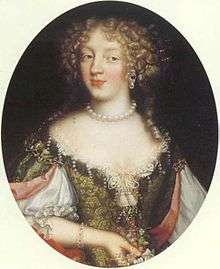Frances Talbot, Countess of Tyrconnell
| Frances Talbot Countess of Tyrconnell | |
|---|---|
 "La Belle Jennings" | |
| Born |
c. 1647 Sandridge, Hertfordshire |
| Died |
9 March 1730 Dublin |
| Known for | Restoration-era beauty |
| Spouse(s) |
Sir George Hamilton, Comte de Hamilton Richard Talbot, 1st Earl of Tyrconnell |
| Children | 3 |
| Parent(s) |
Richard Jennings Frances Thornhurst |
Frances Talbot, Countess of Tyrconnell (née Jennings, previously Hamilton; c. 1647 – 9 March 1730) was a prominent figure in the Restoration court, together with her younger sister, Sarah Jennings. Once a maid of honour to the Duchess of York, she was twice widowed and eventually died in poverty.
Early life
The daughter of Richard Jennings and Frances Thornhurst, Frances was born at Sandridge, Hertfordshire, England. Her beauty earned her the nickname "La Belle Jennings." Macaulay describes her as “beautiful Fanny Jennings, the loveliest coquette in the brilliant Whitehall of the Restoration."[1] In 1664, Frances was appointed maid of honour to the Duchess of York, Anne Hyde. Wild and reckless as a girl, Pepys records an incident in which she disguised herself as an orange seller, but was eventually recognised by her expensive shoes.
Comtesse de Hamilton
In 1665, Frances married Sir George Hamilton, Comte de Hamilton, maréchal de camp, son of Sir George Hamilton, 1st Baronet, and Mary Butler, daughter of Lord Thurles. With him, she had three daughters:
- Elizabeth (1667–1724), who married Richard Parsons, 1st Viscount Rosse in 1685 and was mother of Richard Parsons, 1st Earl of Rosse
- Frances, who married Henry Dillon, 8th Viscount Dillon in 1687
- Mary (1676–1736), who married Nicholas Barnewall, 3rd Viscount Barnewall in 1688
Countess of Tyrconnell

After Hamilton's death, Frances remarried in 1681 to an old suitor she had previously rejected: Richard Talbot. Talbot was later created Earl of Tyrconnell in the peerage of Ireland and subsequently Duke of Tyrconnell, although this latter title was bestowed by James II after the Glorious Revolution and was not widely recognised. Nonetheless, Frances is frequently called Duchess of Tyrconnell.[2] They had no children.
Her husband was appointed as Lord Deputy of Ireland and the couple lived in Dublin. He oversaw a dramatic expansion of the Irish Army, transforming it from a mainly Protestant to a Catholic force which fought on belalf of James II during the Williamite War in Ireland. Following his defeat at the Battle of the Boyne, the king fled to their home and was met by Frances. King James remarked, ‘Your countrymen, madam, can run well’. Lady Tyrconnel replied, ‘Not quite so well as your majesty, for I see that you have won the race’.[3]
After her husband's death during the Siege of Limerick in 1691, Frances was reduced to poverty and for a while, she had a dressmaker’s stall near the Royal Exchange. She dressed in white with her face covered by a white mask and was described as "the white milliner".[4] In the 1840s, this was dramatized and performed as a play at Covent Garden.
Following the accession of Queen Anne, Frances (and her stepdaughter, Charlotte Talbot) had some of her husband's former property restored to them by act of parliament — presumably assisted by her sister's influence with the queen. Eventually she retired to the Dominican Convent at Channel Row, in modern-day Smithfield in Dublin, and lived there as a parlour boarder from 1723-1724.[5] Frances died at the Poor Clares nunnery on North King Street in Dublin. She was buried in St Patrick's Cathedral in Dublin.
A biography of Frances and her second husband — Little Jennings and Fighting Dick Talbot: A Life of the Duke and Duchess of Tyrconnel — by Philip Sergeant was published in 1913.
See also
Notes
- ↑ Macaulay, The History of England from the Accession of James the Second
- ↑ For example in the catalogue of the National Portrait Gallery
- ↑ The Oxford Dictionary of National Biography
- ↑ 'The Strand, southern tributaries - continued', Old and New London: Volume 3 (1878), pp. 100-110. URL: http://www.british-history.ac.uk/report.aspx?compid=45138 Date accessed: 5 April 2008.
- ↑ Annals 1647-1912, Dominican Convent Cabra